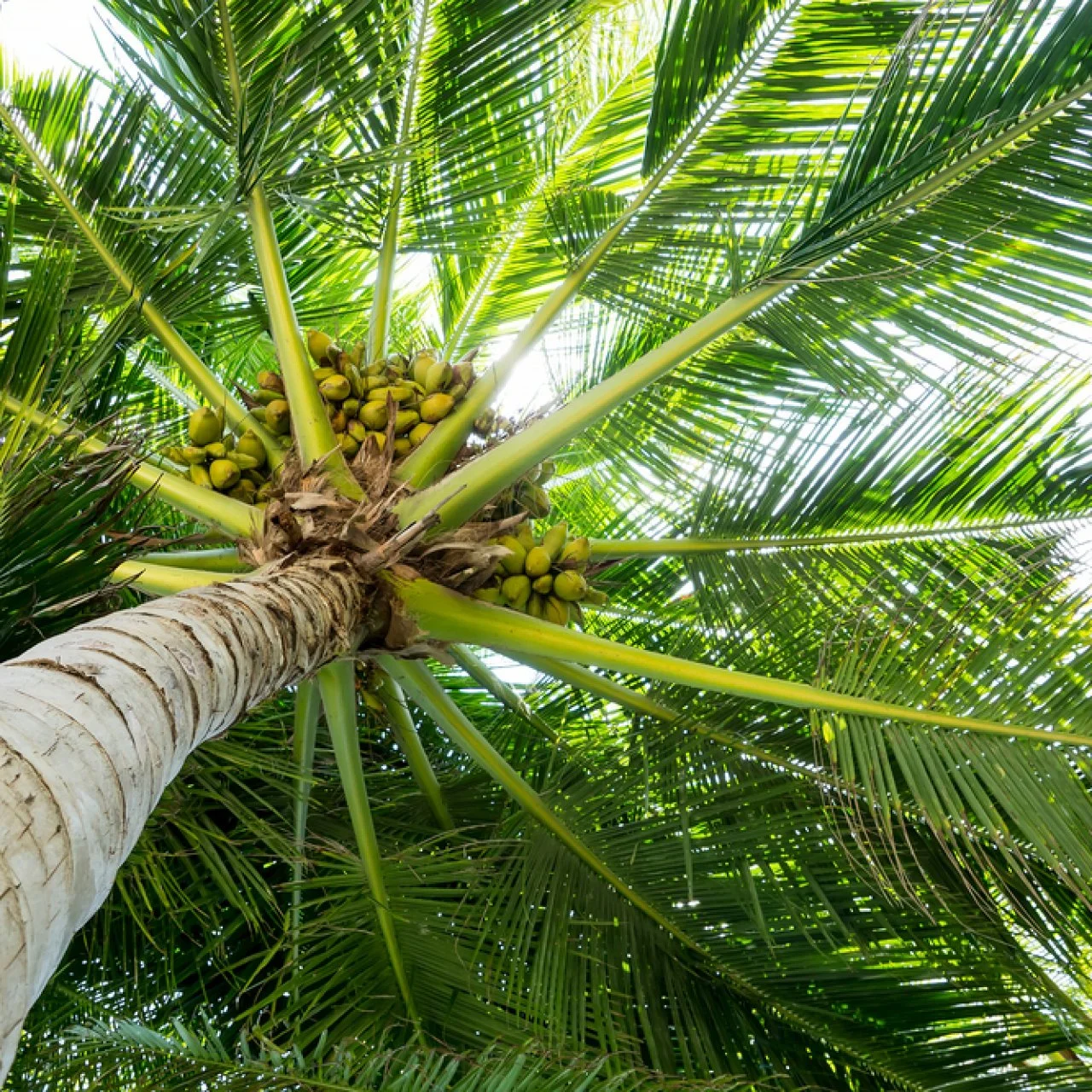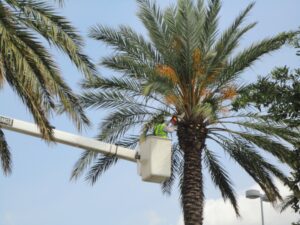20 Varieties of Palm Tree: A Complete Guide to Growing and Using These Tropical Treasures
Palm trees evoke images of tropical paradises, sandy beaches, and exotic landscapes. However, these remarkable plants offer much more than just vacation vibes. With over 2,500 species in the palm family (Arecaceae), these versatile trees can transform your landscape, provide functional benefits, and even serve as sustainable resources. This comprehensive guide explores 20 popular palm varieties suitable for the US market, helping you select, grow, and maximize these botanical wonders in your own space.
Understanding Palm Trees
Before diving into specific varieties, it’s important to understand what makes palm trees unique. Unlike typical hardwood trees, palms are monocots (related to grasses, orchids, and lilies) with no branches or bark. Instead, they grow from a single growing point, producing fronds (leaves) that emerge from the crown. According to the USDA Natural Resources Conservation Service, palm trees are adapted to diverse environments, from tropical rainforests to desert oases.
Palms are classified into two main types:
- Feather palms (pinnate): Fronds resemble feathers with leaflets extending from a central rachis
- Fan palms (palmate): Fronds have a fan-like appearance with leaflets radiating from a central point
Popular Palm Varieties for US Landscapes
Cold-Hardy Palm Options
If you live in cooler regions (USDA Zones 7-9), these palm varieties can withstand occasional freezing temperatures:
1. Windmill Palm (Trachycarpus fortunei)

One of the most cold-tolerant palms, the Windmill Palm can survive temperatures down to 10°F. Its compact size (rarely exceeding 25 feet) makes it perfect for smaller yards. The distinctive hairy trunk and fan-shaped fronds create a striking appearance in any landscape.
Growing tips: Plant in well-draining soil with partial shade in cooler climates. Water deeply but infrequently once established.
2. Needle Palm (Rhapidophyllum hystrix)

The Needle Palm is North America’s most cold-hardy palm, surviving temperatures as low as 0°F. This shrub-like palm rarely grows taller than 6 feet, making it ideal for understory planting or as a textural accent in mixed borders.
Growing tips: Thrives in partial shade with regular moisture. Mulch well before winter in colder zones.
3. European Fan Palm (Chamaerops humilis)

Native to Mediterranean regions, this versatile palm grows in either single or multi-trunk forms. With a mature height of 6-15 feet, it’s perfect for container growing or as a focal point in smaller landscapes. Can withstand temperatures to about 15°F.
Growing tips: Requires full sun and excellent drainage. Drought-tolerant once established.
4. Pindo Palm (Butia capitata)
The Pindo Palm offers both ornamental value and edible fruits (sometimes called “jelly palms”). Its gracefully arching blue-green fronds create a distinctive silhouette. Slow-growing to 15-20 feet, it can tolerate temperatures down to about 15°F.
Growing tips: Plant in full sun with well-draining soil. Tolerates drought but performs best with regular watering.
Tropical Palm Varieties (USDA Zones 10-11)
For warmer regions without significant frost, these tropical varieties thrive:
5. Royal Palm (Roystonea regia)
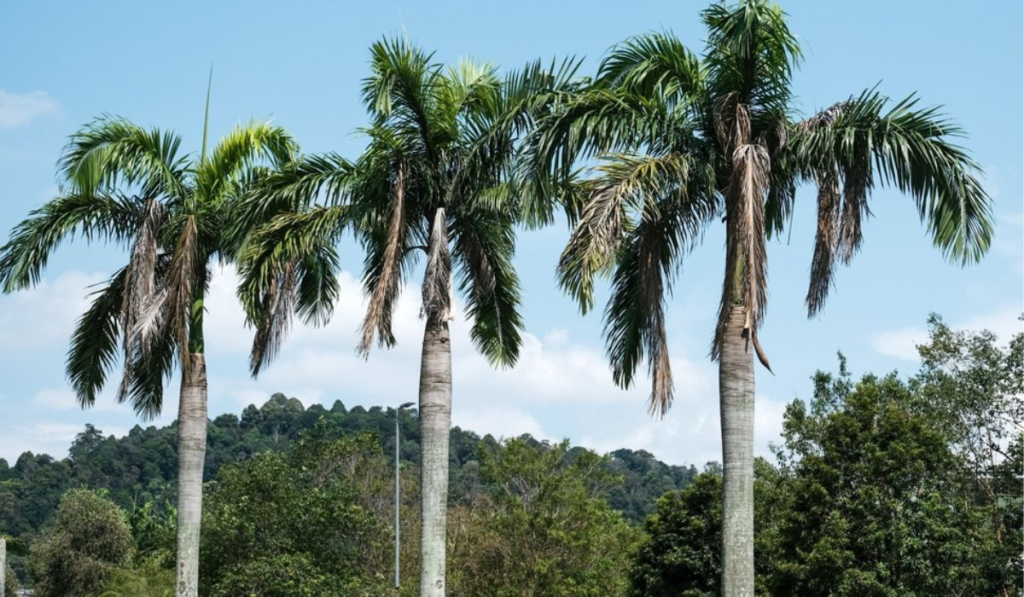
The majestic Royal Palm can reach heights of 50-80 feet, with a smooth, light gray trunk that swells slightly in the middle. Its feathery fronds create a crown shaft that can spread 15-25 feet. Often used in grand boulevard plantings.
Growing tips: Requires full sun and consistent moisture. Not suitable for small yards due to its massive size.
6. Coconut Palm (Cocos nucifera)
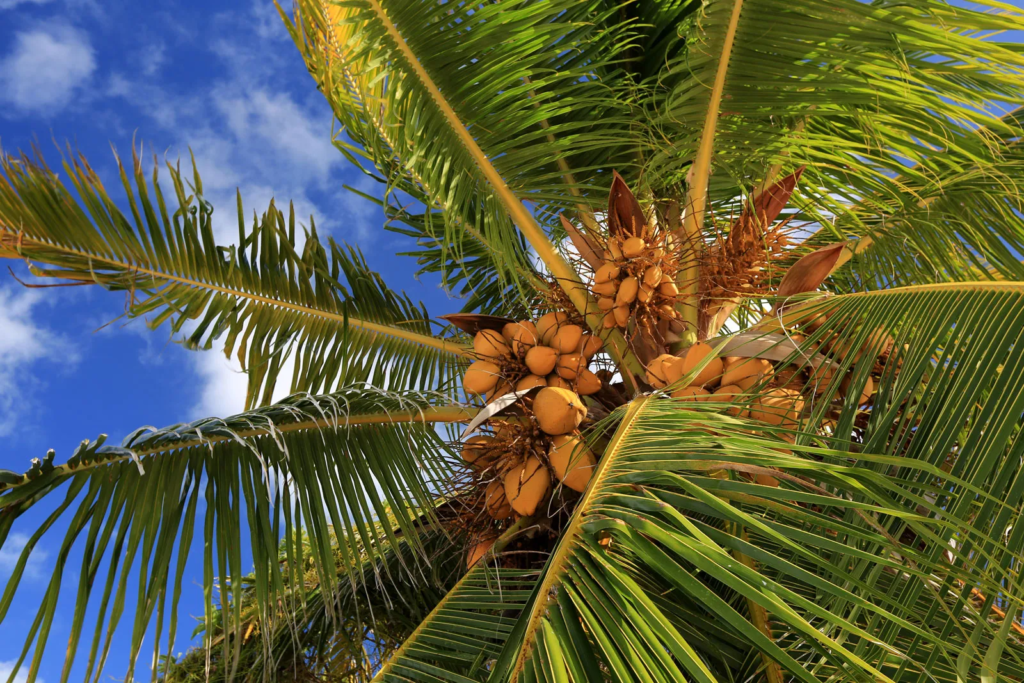
Perhaps the most iconic palm species, the Coconut Palm features a slender, often curving trunk and a crown of feathery fronds. Beyond its ornamental value, it produces edible coconuts. Typically grows 50-100 feet tall in optimal conditions.
Growing tips: Needs full sun, consistent moisture, and protection from strong winds. Requires warm temperatures year-round.
7. Foxtail Palm (Wodyetia bifurcata)
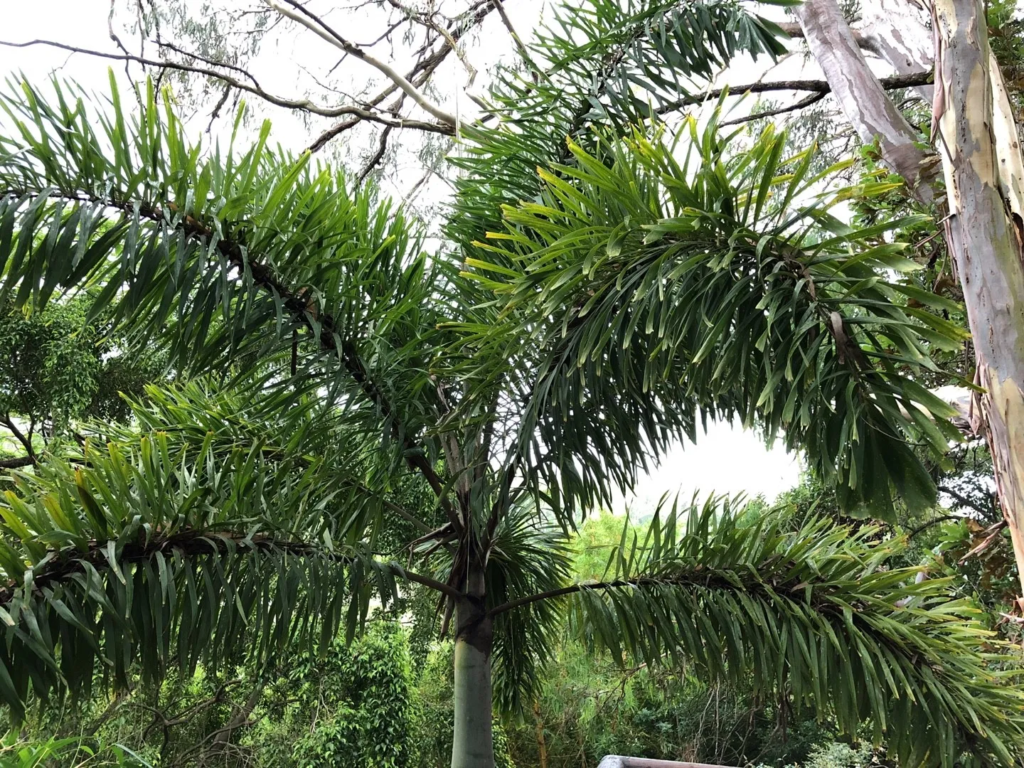
Named for its bushy, fox-tail-like fronds, this Australian native has become popular in American landscapes. Its clean, ringed trunk and symmetrical crown make it an elegant specimen tree. Grows 25-30 feet tall.
Growing tips: Prefers full sun and moist, well-draining soil. Fertilize regularly during growing season.
8. Christmas Palm (Adonidia merrillii)
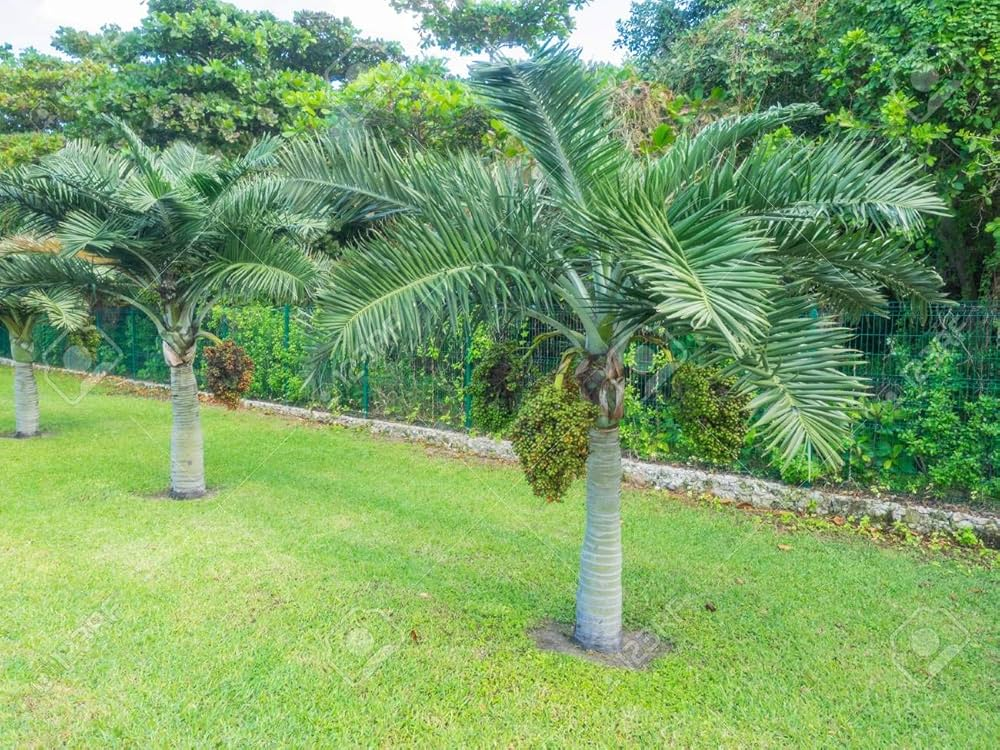
This compact palm (reaching only 15-25 feet) is perfect for smaller tropical landscapes. Named for its bright red fruits that appear around December, it features a smooth gray trunk and feathery green fronds.
Growing tips: Thrives in full sun to partial shade. Regular watering and fertilization promote best growth.
Indoor and Patio Palm Options
For container growing or indoor spaces, these smaller palm varieties excel:
9. Parlor Palm (Chamaedorea elegans)
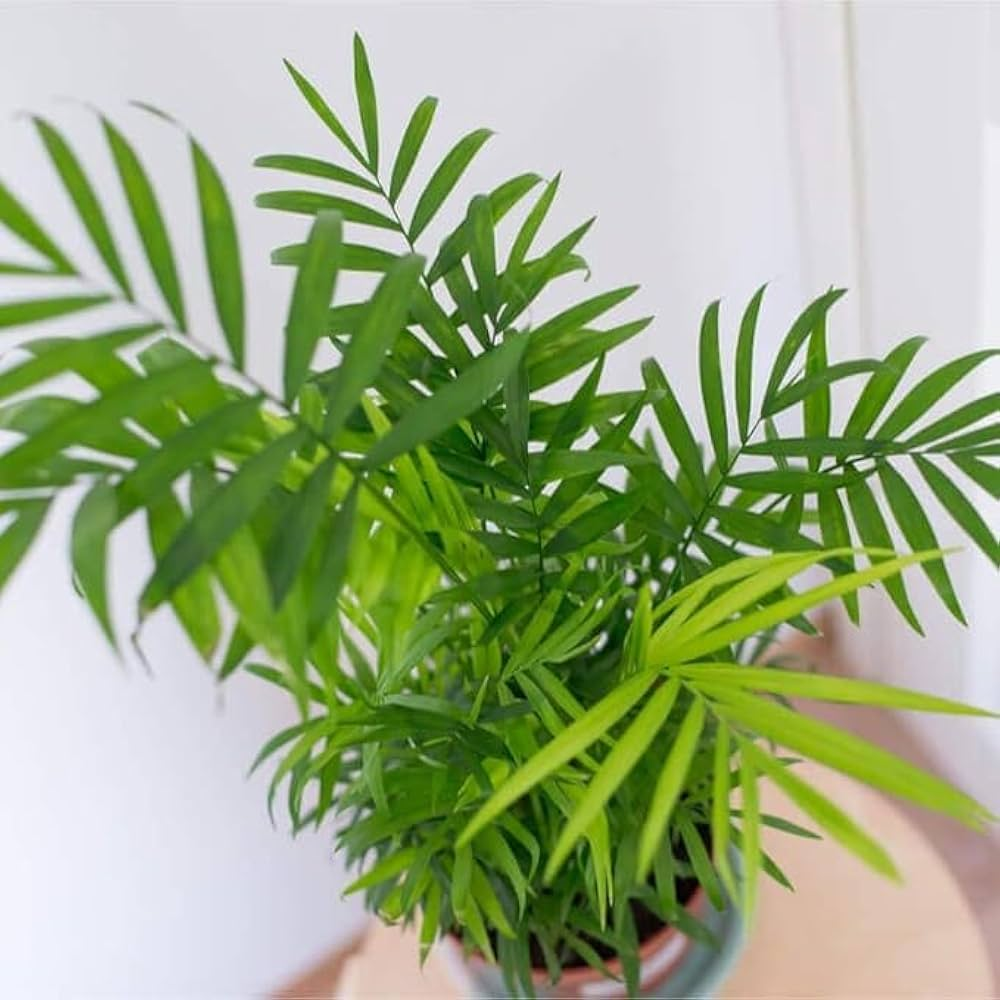
A classic houseplant since Victorian times, the Parlor Palm rarely exceeds 4 feet indoors. Its delicate fronds and tolerance for low light make it perfect for interior spaces.
Growing tips: Grows best in bright, indirect light but tolerates lower light conditions. Keep soil evenly moist but not soggy.
10. Kentia Palm (Howea forsteriana)
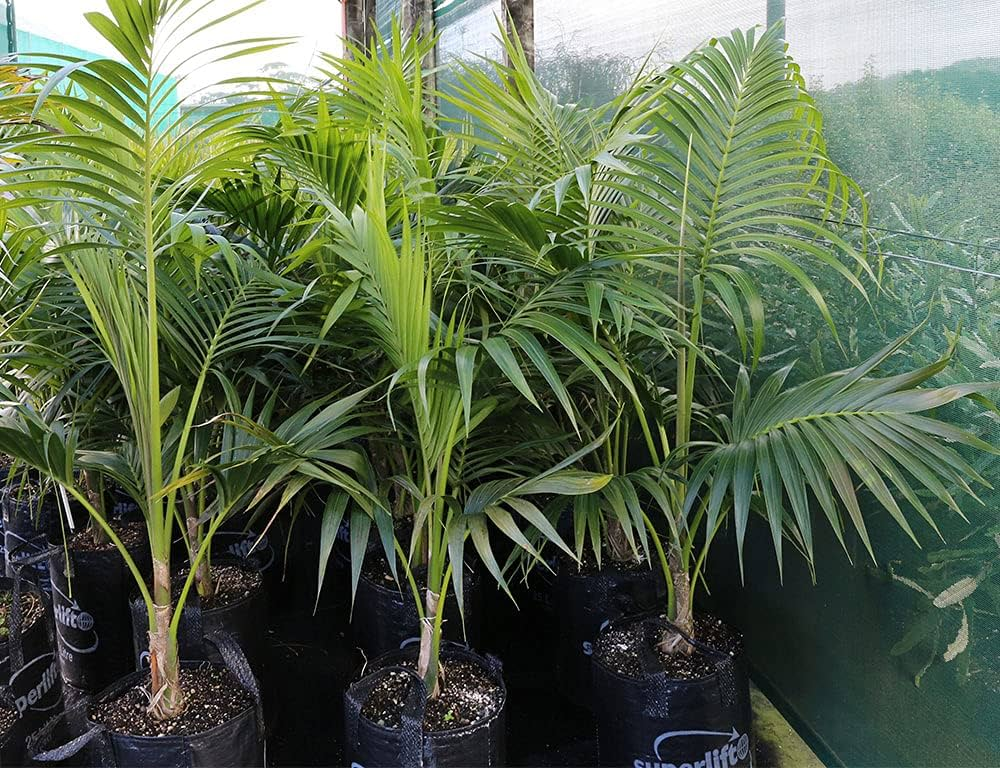
With its elegant, arching fronds and slender trunk, the Kentia Palm is considered one of the finest indoor palms. Slow-growing to 10 feet indoors, it maintains a graceful appearance even in less-than-ideal conditions.
Growing tips: Prefers bright, indirect light but adapts to medium light levels. Allow soil to dry slightly between waterings.
11. Pygmy Date Palm (Phoenix roebelenii)
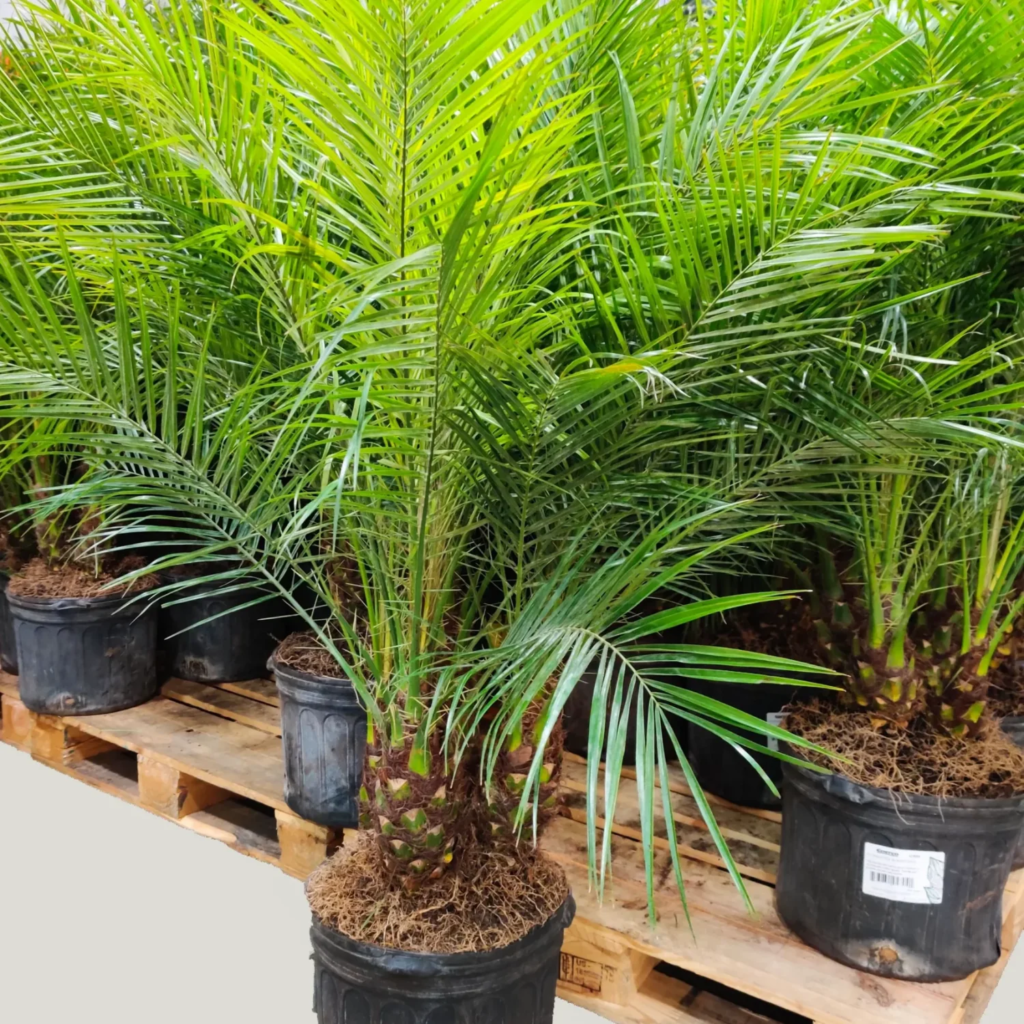
This miniature relative of the commercial date palm grows just 6-12 feet tall. Its fine-textured fronds and slender, spiny trunk create an elegant silhouette perfect for containers or small garden spaces.
Growing tips: Plant in full sun to light shade. Water regularly but ensure good drainage to prevent root rot.
12. Majesty Palm (Ravenea rivularis)
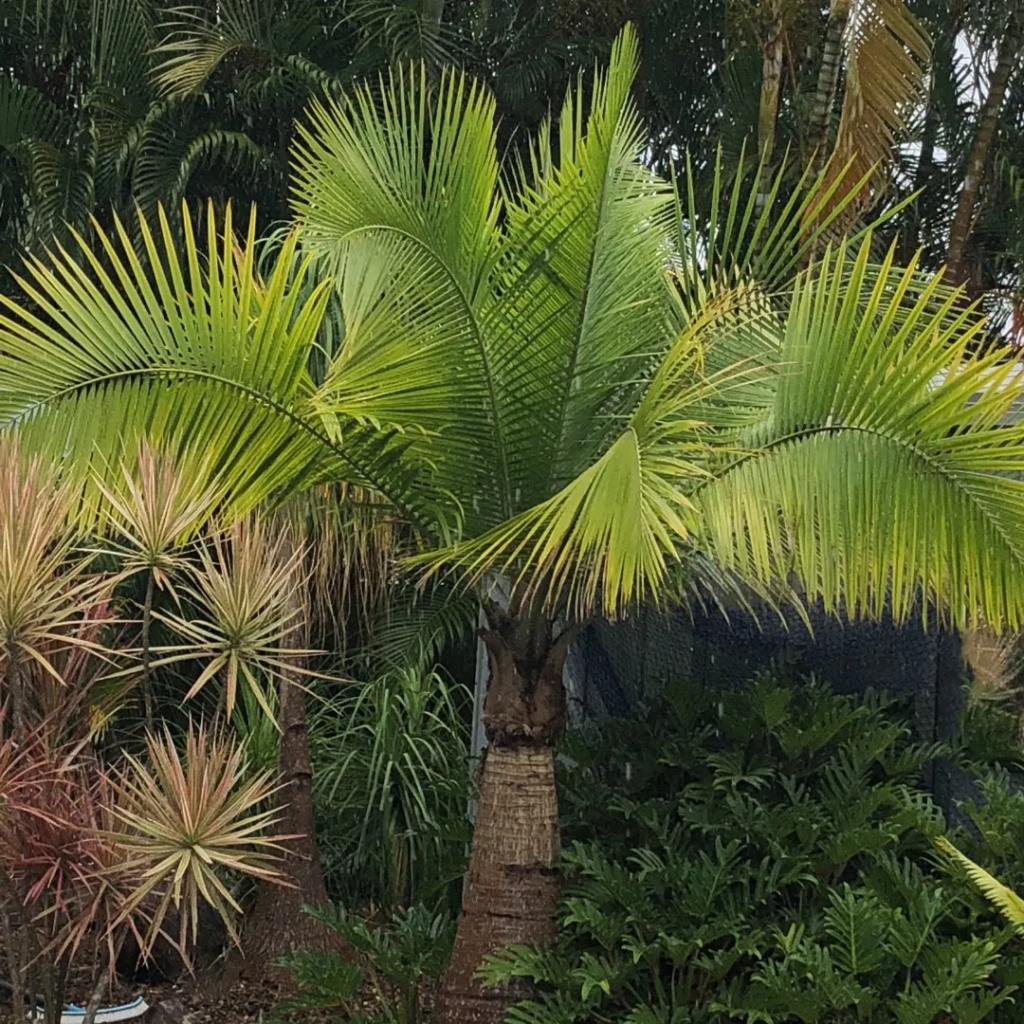
While challenging as a houseplant, this palm is stunning in containers on patios in warm climates. Its feathery fronds create a tropical atmosphere. Can reach 10 feet in containers.
Growing tips: Requires bright, indirect light and consistent moisture. Struggles in dry indoor environments.
Comparison of Palm Tree Varieties
| Palm Variety | Max Height | Cold Hardiness | Growth Rate | Sun Requirements | Water Needs | Special Features |
|---|---|---|---|---|---|---|
| Windmill Palm | 20-25 ft | USDA Zone 7 (10°F) | Slow | Full sun to partial shade | Moderate | Hairy trunk, very cold-hardy |
| Needle Palm | 5-6 ft | USDA Zone 6 (0°F) | Very slow | Partial shade | Moderate to high | Most cold-hardy palm in North America |
| European Fan Palm | 6-15 ft | USDA Zone 8 (15°F) | Slow | Full sun | Low | Drought-tolerant, multi-trunk form available |
| Pindo Palm | 15-20 ft | USDA Zone 8 (15°F) | Slow | Full sun | Low to moderate | Produces edible fruits |
| Royal Palm | 50-80 ft | USDA Zone 10 (30°F) | Moderate | Full sun | High | Majestic boulevard tree |
| Coconut Palm | 50-100 ft | USDA Zone 11 (40°F) | Moderate | Full sun | Moderate to high | Produces coconuts |
| Foxtail Palm | 25-30 ft | USDA Zone 10 (30°F) | Moderate | Full sun | Moderate | Bushy, fox-tail-like fronds |
| Christmas Palm | 15-25 ft | USDA Zone 10 (32°F) | Moderate | Full sun to partial shade | Moderate | Red fruits appear in winter |
| Parlor Palm | 2-4 ft | Indoor only | Slow | Indirect light | Moderate | Excellent low-light tolerance |
| Kentia Palm | 5-10 ft | Indoor only | Very slow | Indirect light | Low to moderate | Elegant indoor specimen |
| Pygmy Date Palm | 6-12 ft | USDA Zone 9 (20°F) | Slow | Full sun to light shade | Moderate | Compact size, spiny trunk |
| Majesty Palm | 10-80 ft | USDA Zone 10 (30°F) | Moderate | Bright indirect light | High | Challenging indoors, best for patios |
Rare and Unique Palm Species
For collectors and enthusiasts seeking something different, these distinctive palms offer unusual characteristics:
13. Bottle Palm (Hyophorbe lagenicaulis)
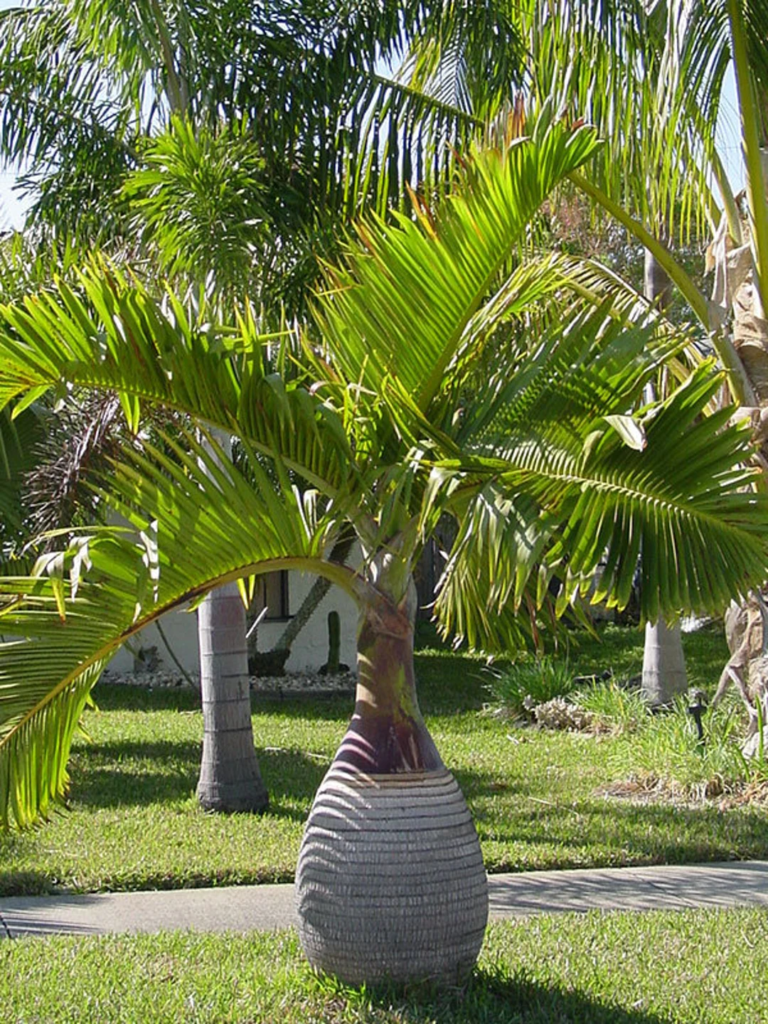
Named for its bulbous, bottle-shaped trunk, this distinctive palm grows only 10-12 feet tall. The swollen base tapers toward the top, creating a unique silhouette unlike any other palm.
Growing tips: Requires full sun and well-draining soil. Highly sensitive to cold temperatures.
14. Triangle Palm (Dypsis decaryi)
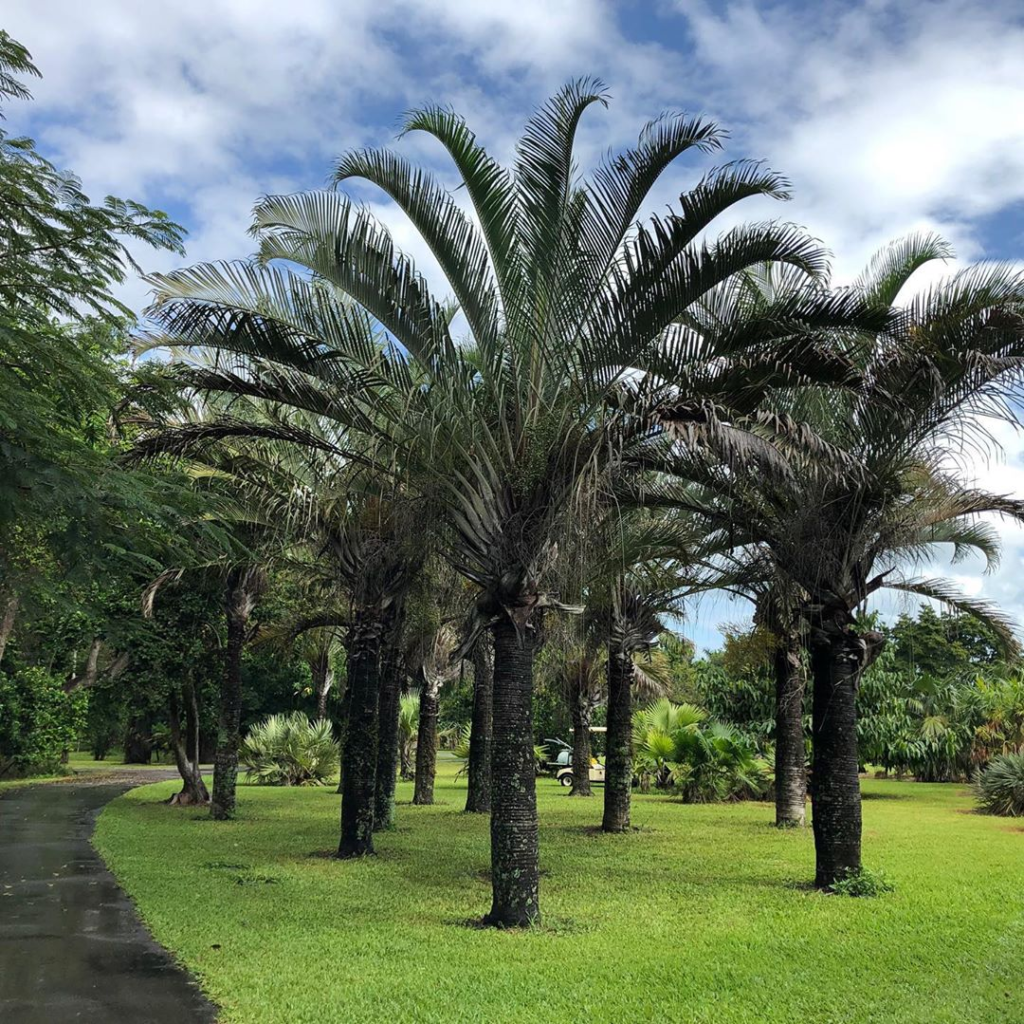
This striking palm features fronds that emerge in three distinct vertical planes, creating a triangular shape when viewed from above. The blue-gray fronds contrast beautifully with the smooth trunk. Grows 15-25 feet tall.
Growing tips: Plant in full sun with well-draining soil. Moderate water needs once established.
15. Fishtail Palm (Caryota spp.)
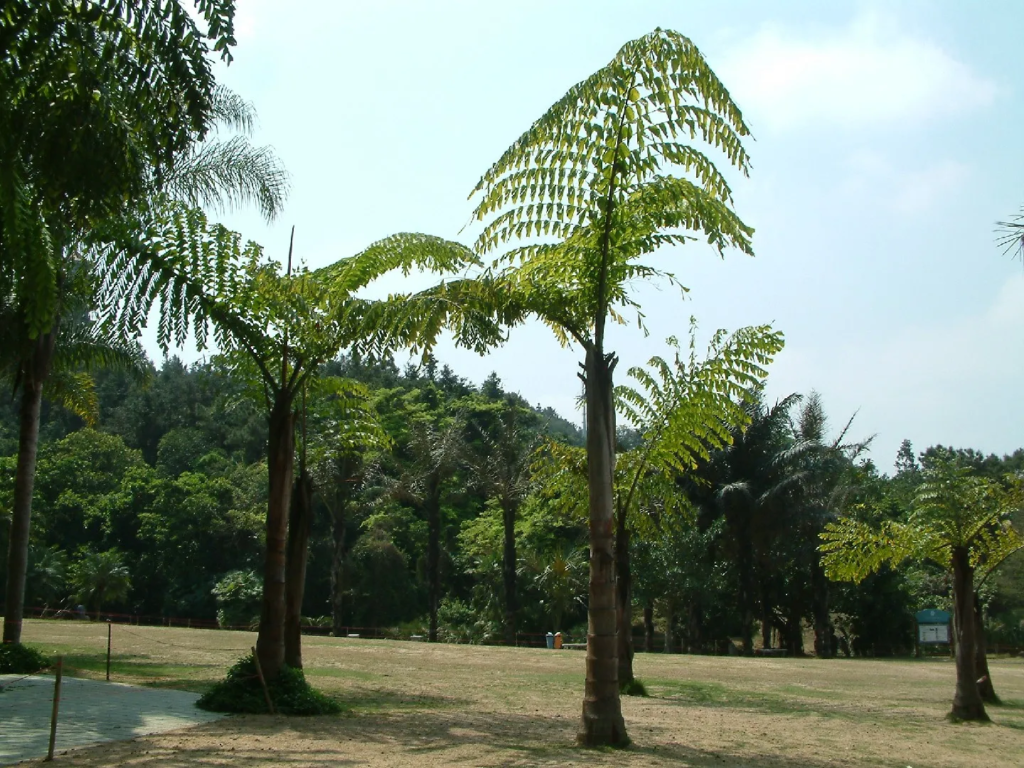
Named for its unusual bi-pinnate fronds that resemble fish tails, this distinctive palm creates a bold tropical statement. Several species exist, ranging from 10-foot shrubby forms to 50-foot giants.
Growing tips: Prefers partial shade and consistent moisture. Cannot tolerate drought.
16. Blue Hesper Palm (Brahea armata)

This striking palm features intensely silver-blue fan-shaped fronds that stand out dramatically in the landscape. Slow-growing to about 20-30 feet, it’s perfect as a focal point.
Growing tips: Requires full sun and excellent drainage. Highly drought-tolerant once established.
Palm Trees for Specific Landscape Uses
17. Bismarck Palm (Bismarckia nobilis)

With massive silvery-blue fan-shaped fronds reaching up to 10 feet across, the Bismarck Palm creates an unmistakable statement in large landscapes. Its imposing size (up to 30 feet tall and wide) requires ample space.
Best landscape use: Spectacular specimen tree for large properties with open space.
Growing tips: Requires full sun and excellent drainage. Drought-tolerant once established.
18. Mexican Fan Palm (Washingtonia robusta)
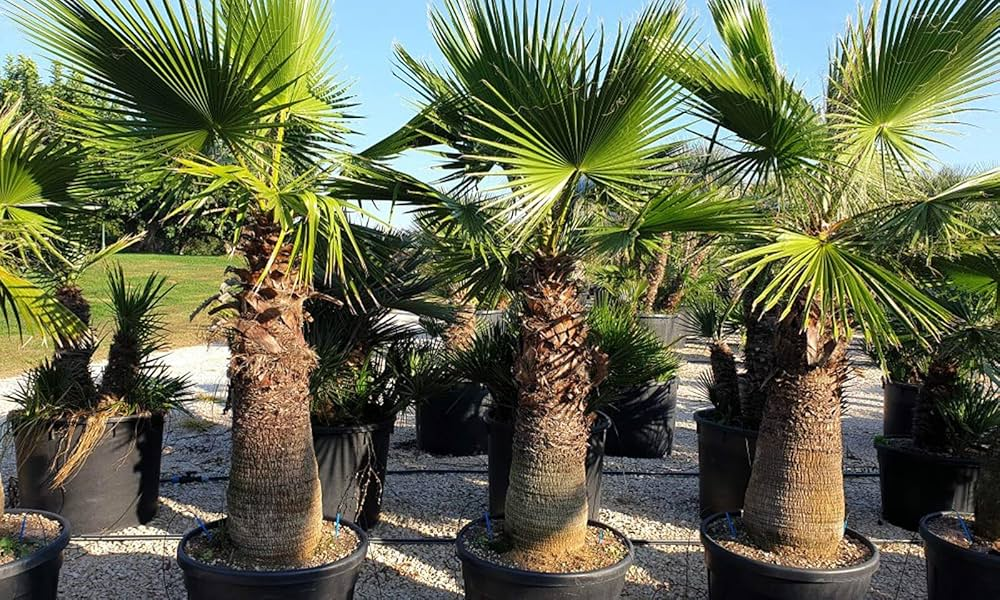
Known for its extremely tall, slender trunk that can reach heights of 70-100 feet, this palm creates the classic “skyline” look associated with Southern California and Miami. Often planted in rows along streets or driveways.
Best landscape use: Dramatic vertical accent, especially when grouped in rows.
Growing tips: Extremely adaptable to various soil types. Drought-tolerant and fast-growing.
19. Areca Palm (Dypsis lutescens)
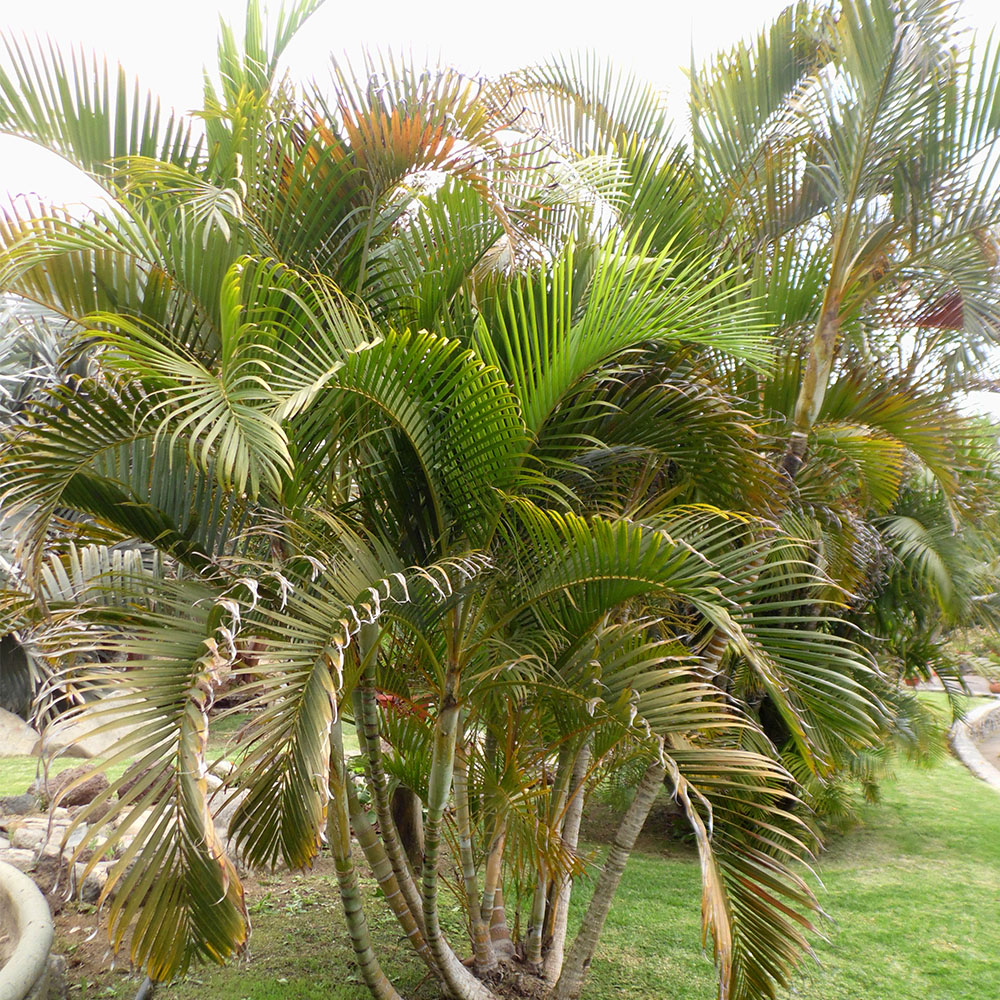
This multi-stemmed palm creates a dense, bushy appearance, making it ideal for privacy screens or as a living fence. Grows 15-20 feet tall in landscapes (smaller in containers).
Best landscape use: Natural privacy screen, container specimen, or indoor plant.
Growing tips: Prefers partial shade and consistent moisture. Yellowing fronds indicate nutrient deficiencies.
20. Sago Palm (Cycas revoluta)

Though not a true palm (it’s actually a cycad), the Sago Palm is commonly sold alongside palms and creates a similar aesthetic. Its stiff, glossy fronds emerge from a central growing point, creating a symmetrical crown. Extremely slow-growing, reaching just 3-5 feet tall over many decades.
Best landscape use: Architectural accent in Asian-inspired gardens, container specimen.
Growing tips: Adaptable to sun or partial shade. Requires excellent drainage; susceptible to rot in wet conditions.
Caring for Palm Trees
Successful palm cultivation requires understanding their specific needs:
Planting and Establishment
When planting new palms, follow these guidelines for best results:
- Timing: Plant during the warm season to encourage root establishment before winter.
- Hole preparation: Dig a hole twice as wide as the root ball but no deeper.
- Planting depth: Position the palm so the root ball sits at the same level as it was in its container.
- Backfilling: Use native soil without amendments for backfilling.
- Watering: Create a water basin around the newly planted palm and water deeply.
- Mulching: Apply 2-3 inches of mulch around the base, keeping it away from the trunk.
Ongoing Maintenance
Established palms require specific care to thrive:
- Watering: Most palms prefer consistent moisture but not soggy conditions. Water deeply when the top 2-3 inches of soil feels dry.
- Fertilization: Use a specialized palm fertilizer containing micronutrients, especially manganese, iron, and magnesium, to prevent deficiencies.
- Pruning: Remove only dead or severely damaged fronds. Never cut the top off a palm (“hurricane cut”), as this can kill the tree.
- Winter protection: In marginal climates, wrap trunks with burlap and cover the crown during freezes.
Common Palm Problems
Watch for these issues in your palm trees:
- Nutrient deficiencies: Yellowing or spotting on fronds often indicates manganese or potassium deficiency.
- Pests: Scale insects, spider mites, and palm weevils can damage palms. Regular inspection helps catch problems early.
- Diseases: Fungal problems like Ganoderma butt rot can be fatal. Proper spacing and avoiding trunk injuries helps prevent disease.
- Environmental stress: Improper planting, over-pruning, and mechanical damage are common causes of palm decline.
Sustainability and Palm Trees
Palm trees offer various environmental and sustainable benefits:
- Carbon sequestration: Palms capture and store carbon dioxide from the atmosphere.
- Urban cooling: Their canopies provide shade that reduces ambient temperatures in urban areas.
- Wildlife habitat: Many palm species provide food and shelter for birds and beneficial insects.
- Erosion control: Palm root systems help stabilize soil on slopes and coastal areas.
The US Forest Service recognizes the importance of palm trees in urban forestry programs, particularly in southern states where they contribute significantly to the urban tree canopy.
Conclusion
Palm trees offer extraordinary versatility for American landscapes, with options suitable for nearly every climate zone and garden style. By selecting appropriate varieties for your region and providing proper care, you can enjoy these majestic plants for generations. Whether you’re seeking dramatic vertical accents, tropical atmosphere, or unique botanical specimens, the diverse world of palm trees has something to offer your landscape.
When selecting palms for your property, consider not just their current size but their mature dimensions, growth rate, and specific cultural requirements. With proper placement and care, these iconic trees will transform your landscape with their distinctive tropical elegance while providing valuable environmental benefits.
